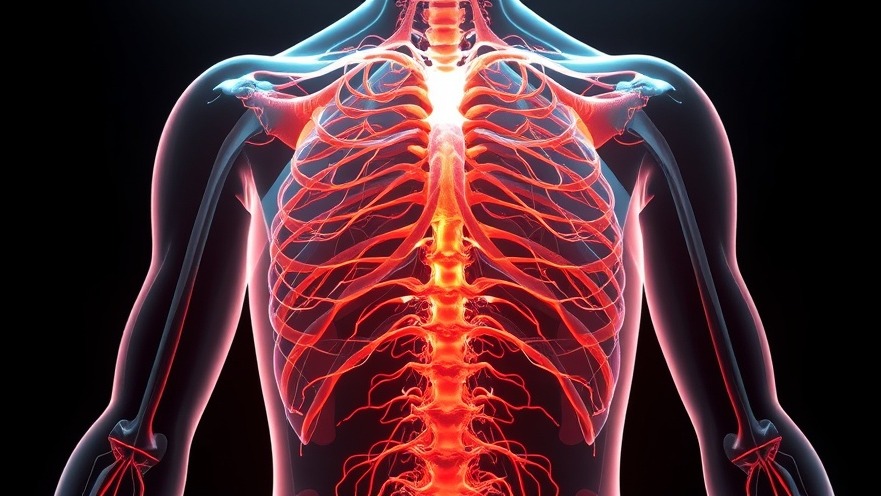Did you know that over 20 million Americans live with a peripheral nerve disorder—many without even knowing it? Your nerves aren't just responsible for movement; they're your body's communication superhighway, quietly shaping every sensation and action day and night. Today, new research reveals that nerve health may be the true foundation of lifelong comfort, resilience, and pain-free living. Let’s unlock the secrets of your nervous system and discover how a few key changes could transform your quality of life.
Why Nerve Health Is Critical: Revealing the Startling Reality Behind Nerve Pain and Disorders
Unlocking the Numbers: Nerve Disorders and Pain in Modern Society
"Recent estimates suggest over 20 million Americans experience some form of peripheral nerve disorder—a silent epidemic affecting quality of life and longevity."
The nervous system is central to every experience and movement, yet nerve disorders often go unnoticed until pain demands attention. While the statistics are staggering, what’s more shocking is how frequently symptoms are dismissed. Many people attribute tingling, numbness, or burning as simple fatigue or aging, but these can be the first signs of underlying nerve disorders or even a progressing peripheral nerve disorder. Pain, weakness, and numbness may ultimately seep into daily routines, quietly impacting overall quality of life.
Chronic nerve pain doesn’t just influence physical health—it can take a toll on mental wellness, work productivity, and social engagement. Physicians and researchers alike recognize the urgency as diagnoses of peripheral neuropathy and other nerve issues are on the rise. Every new case underscores why caring for nerve health is essential to preserving comfort, movement, and independence as we age. Early awareness is the first step toward minimizing long-term damage and keeping the body’s intricate network resilient for years to come.

Defining Nerve Health: Foundation of a Resilient Nervous System
The Role of the Nervous System and Peripheral Nerves in Everyday Life
Your nervous system is a complex web, reaching from your brain and spinal cord (the central nervous system) to every muscle and organ via the peripheral nerves. These connections are vital for sensing surroundings, controlling movement, and even healing from injury. Whether you’re tying your shoes, savoring a meal, or dodging a stubbed toe, it’s your nervous system quietly orchestrating each response—and healthy nerves are crucial to its performance.
When functioning optimally, nerves transmit messages with lightning speed. They help regulate heartbeat, coordinate reflexes, and manage pain, temperature, and pressure. If nerve health falters due to injury, disease, or lifestyle, these signals can become scrambled, resulting in symptoms like muscle weakness, numbness, or even unrelenting pain. Strong nerve health allows individuals to maintain independence, participate in active lifestyles, and enjoy life’s simple pleasures without the shadow of discomfort or disability.

Nerve Health vs. Nerve Disorders: Understanding the Balance
The delicate equilibrium between nerve health and nerve disorders hinges on factors from genetics to daily habits. Strong, healthy nerves can repair themselves from minor injuries, whereas chronic conditions or neglect may tip the balance toward persistent pain or dysfunction. Understanding this balance empowers individuals to take proactive steps—like modifying diet or managing chronic disease—to strengthen nerve resilience and avoid degeneration.
Common nerve disorders happen when that control is lost, often due to diabetes, autoimmune issues, trauma, or toxin exposure. When not addressed, these conditions can cause lasting damage and complicate simple activities such as walking or writing. This is why paying attention to early symptoms of nerve disorder is crucial. Timely intervention, influenced by the expertise of your healthcare provider , can help restore balance and ensure better health outcomes.
For those seeking practical ways to ease nerve discomfort and reclaim daily comfort, exploring natural approaches to soothing nerve pain can offer additional strategies that complement the lifestyle and medical guidance discussed here.
How Peripheral Nerve Disorders and Nerve Pain Develop
Common Causes of Nerve Disorders: From Genetics to Lifestyle Choices
While some peripheral nerve disorders are linked to inherited genetic conditions, lifestyle and environmental factors play a significant role for most people. Long-term high glucose levels in those with diabetes commonly trigger peripheral neuropathy. Toxins such as alcohol or certain medications, physical injuries causing pressure or trauma, and chronic illnesses like autoimmune disease can all damage the peripheral nerves.
Modern sedentary lifestyles, poor nutrition, and untreated health issues further increase risk. Deficiencies in essential vitamins such as B12, overuse of certain drugs, or unchecked inflammatory processes can silently impair nerves' ability to send messages. Even repetitive motions (carpal tunnel) or compression (herniated disks impacting the spinal cord ) often lead to a nerve disorder. The intertwining of these causes means prevention requires a holistic approach, targeting diet, exercise, and regular monitoring by a trusted care provider.
Identifying Early Signs of Nerve Pain and Peripheral Neuropathy
Detecting nerve pain or the first signals of a nerve disorder can be tricky because symptoms are often subtle or mistaken for other conditions. Tingling and numbness in the hands or feet that linger or worsen, sharp or shooting pains that disrupt sleep, or a sensation of burning skin may all signal the onset of peripheral neuropathy or related issues. In some cases, muscle weakness or trouble with coordination becomes evident as nerve damage progresses.
Recognizing these warning signs early increases the likelihood of successful intervention with the help of a healthcare provider. The sooner someone acts, the more nerve function can be preserved. If symptoms intensify or disrupt daily living, evaluation by a specialist is strongly advised to distinguish temporary irritation from a more serious nerve disorder.

Symptoms and Diagnosis: A Comprehensive Guide to Monitoring Nerve Health
When to Consult Your Healthcare Provider or Care Provider for Nerve Pain
If you notice persistent tingling, burning, or numbness—especially if symptoms last more than two weeks—don’t ignore them. Other red flags include sharp, shooting pains that grow worse at night, or muscle weakness making simple tasks difficult. These often signal a deeper peripheral nerve disorder that may worsen without proper care.
Consult your healthcare provider if these symptoms are interfering with sleep, mobility, or quality of life. Proactive evaluation, which may include nerve conduction studies or imaging, can help pinpoint the cause and shape a custom treatment plan. Don’t wait for small problems to become chronic; timely partnership with your care provider helps support optimal nerve health and prevents irreversible damage.
Symptom |
Possible Condition |
When to Seek Help |
|---|---|---|
Tingling/Numbness |
Peripheral neuropathy |
Persistent (>2 weeks) |
Burning sensations |
Peripheral nerve disorder |
Nightly, disrupting sleep |
Sharp, shooting pains |
Nerve pain |
Increasing frequency/intensity |
Muscle weakness |
Nerve disorders |
Difficulty with movement |
Supporting Nerve Health: Lifestyle Factors and Preventative Measures
Diet, Exercise, and Their Role in Preventing Peripheral Nerve Disorders
Nutrient-rich diets packed with antioxidants, healthy fats, and B-vitamins are essential for nerve health. Foods like fish, leafy greens, berries, avocados, and nuts help reduce inflammation, maintain healthy glucose levels , and protect against nerve-damaging conditions. Physical activity, especially aerobic exercise and strength training, boosts circulation, supports metabolic health, and helps nerves repair minor daily damage.
Regular exercise also reduces stress—a significant contributor to chronic nerve pain —and can help stave off obesity or diabetes, both major risk factors for nerve disorders. A balanced lifestyle approach, including quality sleep and stress management, is a powerful defense against the slow progression of peripheral nerve disorders. Engaging with your healthcare provider about individual risk factors or family history further tailors this approach, maximizing your nerve system’s potential for resilience.

Supplements and Nutrients Vital for Optimal Nerve Health
While a whole-foods diet is the gold standard, certain supplements may help support nerve health —especially for those with deficiencies or specific risk profiles. B-complex vitamins (especially B12, B6, and folate), alpha-lipoic acid, omega-3 fatty acids, and antioxidants like vitamin E are among the most studied. These nutrients combat oxidative stress, aid in nerve repair, and reduce inflammation throughout the nervous system.
It’s important to consult with a care provider before adding supplements, as the wrong dose or product may interact with existing medications or conditions. When chosen wisely and paired with healthy habits, supplements can bridge nutritional gaps and help maintain the delicate balance around peripheral nerve function and regeneration.
Treating and Managing Chronic Nerve Pain: Current Practices and Innovations
Traditional vs Modern Approaches in Nerve Disorder Management
Modern nerve disorder management integrates both traditional methods—like physical therapy, acupuncture, and herbal remedies—and advanced breakthroughs, including nerve stimulation devices and targeted medications. For some, age-old practices such as yoga or meditation help manage nerve pain by reducing stress hormones, while prescription drugs or physical rehabilitation directly address pain and function.
Recent innovations, including minimally invasive surgery and biologic therapies, target root causes of nerve disorders rather than just symptoms. Each approach is tailored to the severity and source of nerve injury, with interdisciplinary teams involving neurologists, physical therapists, and pain specialists to ensure personalized, comprehensive care. Consulting with your healthcare provider is essential for finding the right combination of treatments and exploring new options as research evolves.

The Role of the Cleveland Clinic and Leading Institutions in Nerve Health Research
Institutions like the Cleveland Clinic are at the cutting edge of nerve health research, pioneering new drug trials, non-surgical interventions, and rehabilitation programs designed to restore nerve function. These academic medical centers conduct large-scale studies, share best practices, and offer multidisciplinary clinics to address complex neuropathies. Their ongoing work is helping shape the future of nerve pain management with advanced treatments and a focus on preventive care.
By participating in or following the progress of these renowned research centers, patients can access emerging therapies and clinical trial opportunities. The Cleveland Clinic's commitment is to move the science forward, ensuring that evidence-based treatments benefit the greatest number of people with nerve disorders.
Your Nerve Health Strategy: Action Steps for a Pain-Free Future
Schedule regular checkups with your healthcare provider.
Incorporate nerve-healthy foods and exercise.
Identify and reduce risk factors for nerve disorders.
Use supplements mindfully to support peripheral nerve function.
Stay informed about nerve pain research and treatments.
What helps nerves heal?
Key Factors in Nerve Recovery and Realistic Expectations
The body has a remarkable ability to heal mild nerve damage , but recovery depends on the type and cause of injury. Rest, balanced nutrition, and medical interventions can help nerves regenerate. Physical therapy and gentle exercise improve blood flow and support healing. Avoiding toxins (alcohol, certain medications), controlling glucose levels , and reducing chronic inflammation with antioxidant-rich foods are all factors that help nerves recover. Realistically, complete recovery is most likely with early diagnosis, proper treatment, and patience—with peripheral nerves sometimes requiring weeks or months for full repair.
Working closely with a care provider , setting achievable goals, and making consistent lifestyle changes are essential. Severe or longstanding nerve damage may not fully reverse, but pain relief and function can often be significantly improved with a comprehensive approach.
What are 7 foods that may heal nerve damage?
Leafy greens (spinach, kale)
Healthy fats (avocado, olive oil)
Nuts and seeds (walnuts, flaxseed)
Fish rich in omega-3s (salmon)
Berries (blueberries, strawberries)
Eggs
Whole grains (brown rice, quinoa)

How to manage nerve health?
Maintain balanced diet
Exercise regularly
Erase bad habits (smoking, excessive alcohol)
Manage chronic disease
Consult your healthcare provider regularly
How do I repair my nervous system?
Practical Steps Toward Nervous System Restoration
Repairing your nervous system starts with addressing underlying conditions—such as diabetes, vitamin deficiencies, or autoimmune disease—under the guidance of your healthcare provider. Consistent exercise, restorative sleep, and stress reduction (through meditation, yoga, or therapy) create an optimal environment for nerve recovery. Incorporating anti-inflammatory foods, avoiding known toxins, and scheduling regular medical reviews are fundamental for protecting and enhancing nerve function.
Pain management tools, physical therapy, and innovative treatments recommended by your care team can also accelerate healing. Although full recovery from severe nerve disorders may not always be possible, substantial improvements and a dramatic reduction in nerve pain are realistic with a multidisciplinary and proactive strategy.
Expert Insights: Quotes from Nerve Health Specialists
"A healthy nervous system is the cornerstone of every experience and sensation—prioritize nerve care for lifelong wellness." — Dr. Susan Lee, Neurology, Cleveland Clinic
Frequently Asked Questions About Nerve Health, Disorders, and Pain Management
What are the early warning signs of a nerve disorder?
Early signs include persistent tingling, numbness, burning sensations, sharp pains, or muscle weakness. These often develop gradually and may be mistaken for other issues. If symptoms persist or worsen, consult your healthcare provider to evaluate for possible nerve disorder or peripheral neuropathy.Can nerve damage be reversed?
Mild or early-stage nerve damage is often reversible with timely care, healthy lifestyle choices, and medical support. Chronic or severe cases may not be fully cured, but treatments can manage symptoms and prevent further progression of nerve pain.Are supplements effective for nerve health?
Supplements like B-vitamins, omega-3 fatty acids, and antioxidants may help optimize nerve health , particularly in those with deficiencies. Discuss any supplements with your care provider to ensure safety and appropriateness for your specific needs.How does aging impact peripheral nerve health?
As we age, natural wear and tear, reduced circulation, and chronic diseases can impact peripheral nerve function. Adopting good lifestyle habits and seeing your healthcare provider for routine checks can help preserve nerve health with aging.
Key Takeaways for Maintaining Healthy Nerves and Preventing Peripheral Nerve Disorders
Nerve health supports pain-free living and daily function.
Peripheral nerve disorders are common but manageable.
Consistent lifestyle choices can prevent nerve pain.
Medical support and research continue to advance care.
Give your nerve health a boost with NervoLink - Click here now!
What You'll Gain From Mastering Nerve Health Strategies
In-depth understanding of the nervous system and nerve disorders.
Clarity on preventing and managing nerve pain.
Expert-approved lifestyle changes for nerve health.
Resources for further support from leading care providers.
Conclusion
Take action today—adopt nerve-healthy habits, consult your care provider regularly, and stay informed to keep your nerves resilient and your life pain-free!
If you’re inspired to take your understanding of nerve health even further, consider exploring the latest scientific breakthroughs in nerve regeneration. Advances in RNA research are opening new doors for enhanced peripheral nerve recovery and long-term resilience. By staying informed about these cutting-edge developments, you can empower yourself with knowledge that may shape the future of pain management and nerve care. Discover how emerging science is redefining what’s possible for nerve healing by reading about breakthroughs in peripheral nerve regeneration and take the next step toward a healthier, pain-free life.
 Add Element
Add Element  Add Row
Add Row 




Write A Comment